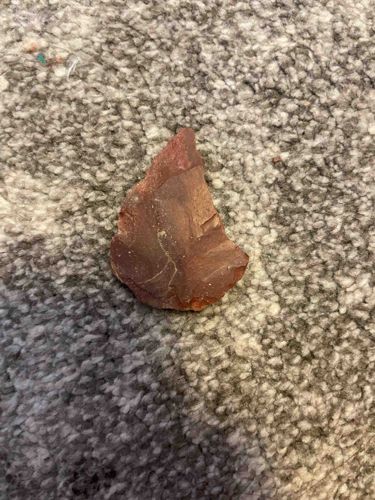
Stone Projectile Point (Likely Arrowhead or Spearhead)
This appears to be a stone projectile point, commonly referred to as an arrowhead or spearhead. It is crafted from a reddish-brown chert or similar fine-grained siliceous rock, exhibiting varying shades of red and brown. The material displays conchoidal fracture patterns characteristic of worked stone, with visible flake scars across its surfaces. The overall shape is triangular with a slightly asymmetrical form, tapering towards a pointed distal end. The basal end, while not perfectly symmetrical, widens slightly. Examining the edges, there is evidence of flaking along the perimeter, indicating bifacial reduction, although the quality of the flaking varies; some flakes appear broad and less refined, while others suggest more deliberate pressure flaking. There is no clear stem or notching visible in the present image, suggesting it might be a preform, a simple triangular point, or the image angle obscures these features. The surface shows a dull to semi-glossy finish, consistent with patination over a long period. There are some minor chips and wear visible along the edges, which could be from use, post-depositional damage, or the manufacturing process itself. No discernible manufacturing marks or signatures are present, as is typical for such artifacts. Based on its material and flaking technique, it likely dates to a prehistoric period, potentially from the Archaic to Woodland periods, depending on regional typology. The craftsmanship appears functional rather than highly artistic, typical for utilitarian artifacts.
AI-Generated Appraisal Disclaimer
Estimated Value
$40-75
Basic Information
Category
Archaeological Artifact/Stone Tool
Appraised On
November 28, 2025
Estimated Value
$40-75
Item Description
This appears to be a stone projectile point, commonly referred to as an arrowhead or spearhead. It is crafted from a reddish-brown chert or similar fine-grained siliceous rock, exhibiting varying shades of red and brown. The material displays conchoidal fracture patterns characteristic of worked stone, with visible flake scars across its surfaces. The overall shape is triangular with a slightly asymmetrical form, tapering towards a pointed distal end. The basal end, while not perfectly symmetrical, widens slightly. Examining the edges, there is evidence of flaking along the perimeter, indicating bifacial reduction, although the quality of the flaking varies; some flakes appear broad and less refined, while others suggest more deliberate pressure flaking. There is no clear stem or notching visible in the present image, suggesting it might be a preform, a simple triangular point, or the image angle obscures these features. The surface shows a dull to semi-glossy finish, consistent with patination over a long period. There are some minor chips and wear visible along the edges, which could be from use, post-depositional damage, or the manufacturing process itself. No discernible manufacturing marks or signatures are present, as is typical for such artifacts. Based on its material and flaking technique, it likely dates to a prehistoric period, potentially from the Archaic to Woodland periods, depending on regional typology. The craftsmanship appears functional rather than highly artistic, typical for utilitarian artifacts.
Get Your Items Appraised
Instant estimates of your treasures with AI-powered instant appraisals